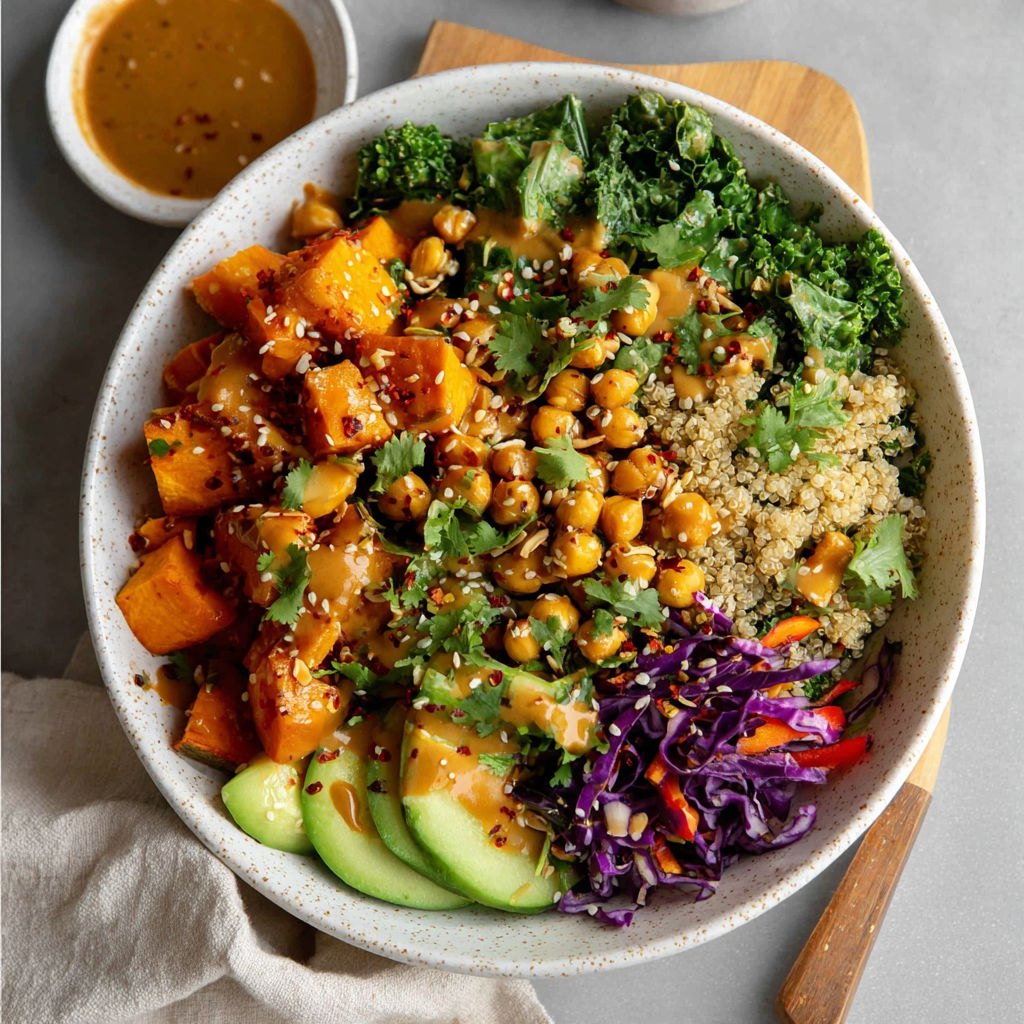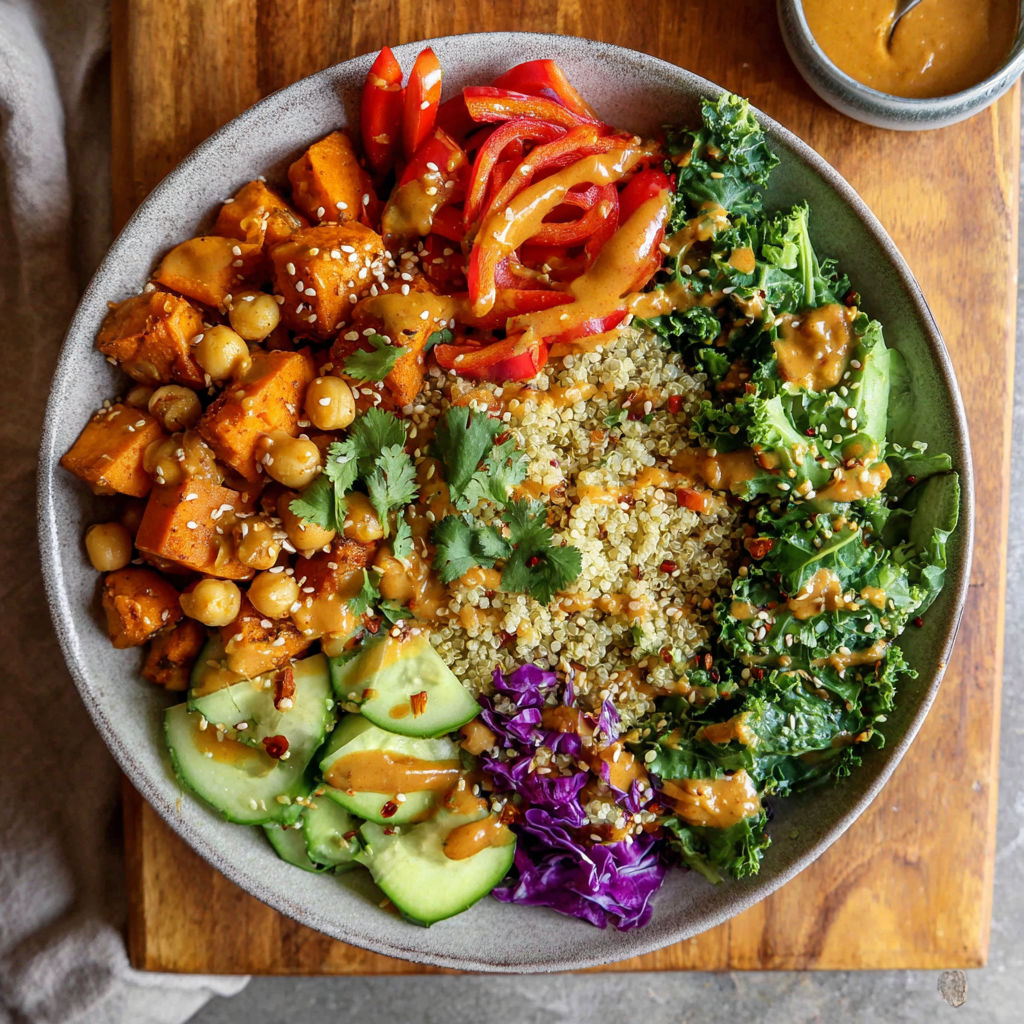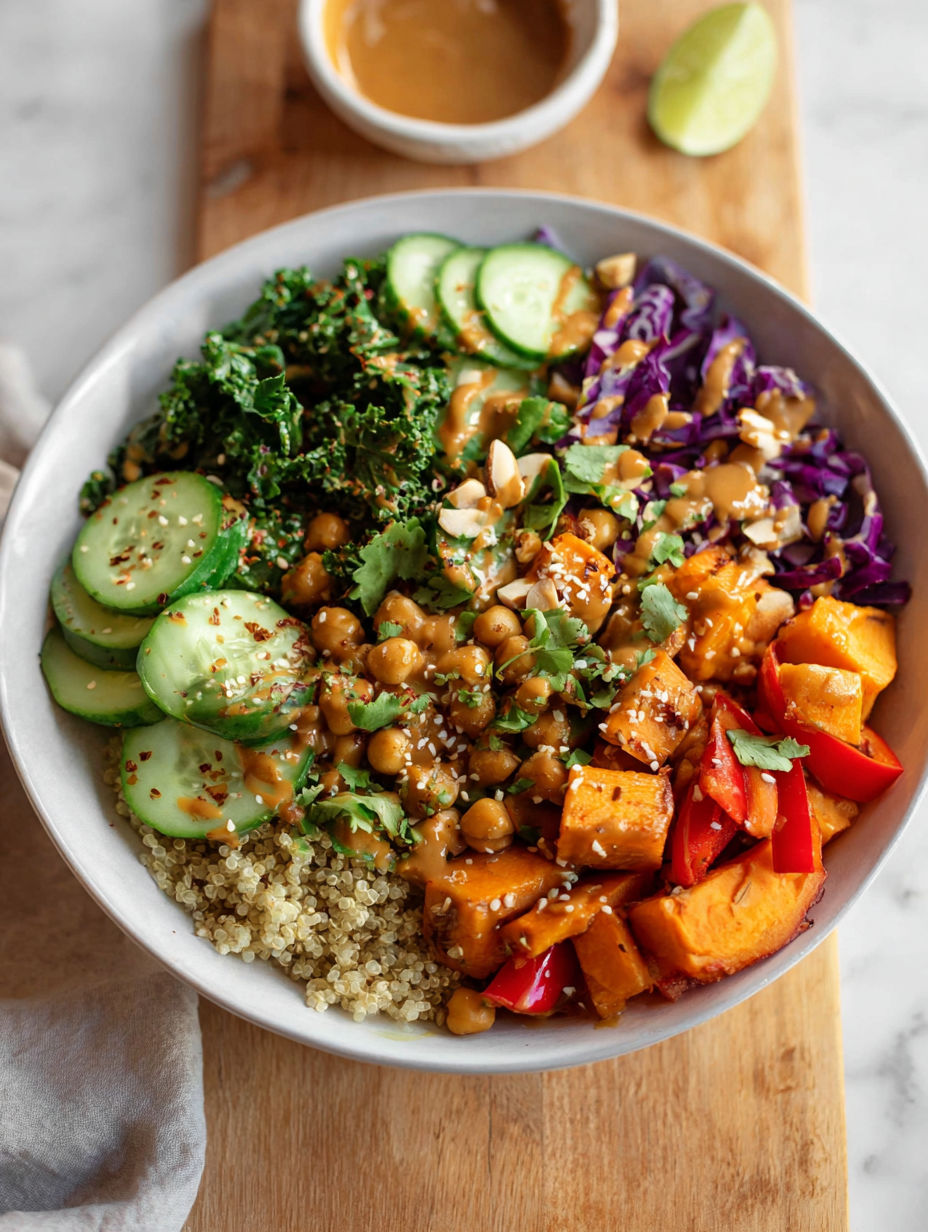 Pin it
Pin it
This colorful Thai Peanut Sweet Potato Buddha Bowl brings together tasty roasted sweet potatoes, nutrient-rich quinoa, and fresh veggies all topped with a smooth peanut sauce that ties everything into a delicious mix. Every bright element adds both eye-catching appeal and different textures with plenty of nutrients in each spoonful.
I came up with this bowl when I started eating more plants and it quickly turned into my favorite lunch. Even my doubtful husband who usually skips veggie meals now asks for this buddha bowl often, which I count as my biggest kitchen win.
Ingredients
- Sweet potatoes: add natural sweetness and substantial texture while giving you vitamin A and fiber
- Quinoa: supplies complete protein and creates a soft base that soaks up sauce wonderfully
- Chickpeas: bring protein and a satisfying bite that makes this bowl really filling
- Mixed greens: create a fresh nutrient-packed foundation
- Red bell pepper: gives sweet crunch and bright color plus vitamin C
- Purple cabbage: brings stunning color, snap and health-boosting compounds
- Cucumber: offers cool crispness and moisture to counter the richer components
- Cilantro: adds fresh herby flavor that works great with Thai-inspired tastes
- Peanuts: give needed crunch and protein while boosting the peanut sauce flavor
- Peanut butter: makes the creamy sauce base with good fats and protein
- Soy sauce: provides savory depth and saltiness to counter the sweetness
- Lime juice: brings necessary tang that lifts the whole dish
- Maple syrup: evens out the savory parts with just the right sweetness
- Fresh ginger and garlic: build flavor complexity that makes the sauce totally addictive
How To Make Thai Peanut Sweet Potato Buddha Bowl
- Roast the sweet potatoes:
- Mix sweet potato cubes with olive oil, salt and pepper until they're all coated. Put them on a baking sheet with space between pieces so they'll roast properly instead of steaming. Bake at 400°F for 25-30 minutes until they're browned at the edges and soft inside.
- Cook the quinoa:
- Wash quinoa well in cold water to get rid of any bitter taste. Mix with water using a 1 to 2 ratio in a pot and let it boil. Turn down the heat, cover and cook for 15 minutes until the water's gone and tiny spirals appear. Keep covered for 5 more minutes then stir with a fork to fluff it up.
- Prepare the peanut sauce:
- Mix peanut butter, soy sauce, lime juice, maple syrup, chopped garlic and grated ginger in a bowl until it's totally blended. Add water one spoon at a time until it's thin enough to pour but still thick. Try it and tweak the flavor with more lime for tang or maple syrup for sweetness.
- Warm the chickpeas:
- Put a little oil in a small pan over medium heat. Add washed chickpeas with a bit of salt and spices like cumin or paprika if you want. Heat for 3-5 minutes until they're warm and slightly crunchy outside.
- Assemble your bowls:
- Start with plenty of mixed greens in each bowl. Add sections of sweet potatoes, quinoa and warm chickpeas around the bowl. Place bright red pepper slices, purple cabbage shreds and cucumber to make a rainbow of colors.
- Finish and serve:
- Pour plenty of Thai peanut sauce over each bowl. Scatter chopped cilantro and peanuts on top for freshness and crunch. Eat right away or store parts separately for later meals.
The peanut sauce really makes this dish special and I've tweaked it for years to get it just right. My grandma who spent time living in Thailand once tried it and said it reminded her of Bangkok street food. That family food connection across years made this recipe mean even more to me.
Make Ahead & Storage Tips
These buddha bowls work great for planning ahead since you can prep everything up to 3 days early. Keep all the parts in separate sealed containers in your fridge. Put the sauce in a small bottle and the peanuts and cilantro in their own little containers. When you're ready to eat, just build your bowl and add the sauce and toppings. You can warm up the sweet potatoes and quinoa if you want, but they taste great at room temperature too.
Ingredient Substitutions
This recipe is super flexible based on what's in your kitchen. Try butternut squash or regular potatoes instead of sweet potatoes. Switch quinoa for brown rice, farro or cauliflower rice if you want fewer carbs. No chickpeas around? Go with edamame, black beans or tofu chunks. The sauce works great with almond butter or sunbutter for folks with peanut allergies, just adjust how sweet it is as needed. For less salt, try coconut aminos instead of soy sauce. Fresh veggies can be swapped based on what's in season, just aim for different colors and textures.
 Pin it
Pin it
Serving Suggestions
While this buddha bowl stands alone as a full meal, I love adding a few extras that make it even better. Coconut lime rice makes a tasty side dish, especially when feeding really hungry people. For more protein, some grilled chicken or shrimp works great on top of the bowl. In summer, I often throw in sliced mango or pineapple for a sweet tropical touch. When having friends over, I set up all the ingredients separately so everyone can make their bowl just how they like it. A small dish of sriracha on the side lets each person make theirs as spicy as they want.
 Pin it
Pin it
Frequently Asked Questions
- → Can I prepare this Thai Peanut Bowl ahead?
Yes, it's great for prepping! Roast the veggies, cook the quinoa, and make the peanut sauce up to three days before. Store them separately and mix them when you're ready to eat. Keep the sauce stored apart for the freshest taste.
- → Is this dish suitable for vegans?
Yep! Just swap honey with maple syrup in the sauce. Everything else is plant-based, making this a delicious vegan meal full of protein.
- → How do I add extra protein to this bowl?
The quinoa and chickpeas add protein, but you can throw in tofu, tempeh, grilled chicken, or salmon for more. Just season, cook, and enjoy with the bowl ingredients.
- → Can I change the veggies in this bowl?
Of course! Switch it up with your favorite veggies or whatever's in season. Try edamame, carrots, avocado, snap peas, or broccoli—they all work beautifully.
- → How spicy is the peanut sauce?
It's pretty mild, but you can spice it up. Add red chili flakes (start with 1/2 teaspoon) or a touch of sriracha or sambal oelek for a bigger kick.
- → Is this dish gluten-free?
Just swap soy sauce with tamari to make it gluten-free. Double-check any other packaged items to make sure they're gluten-free too.
